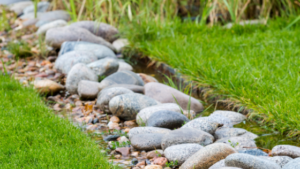If you’ve got problems with your front yard or basement turning into a seriously soggy mess after every storm that rolls through, you understand the frustration that can develop because of water leaking where it shouldn’t be. One option that can help you fix the problem is installing a French drain. But what is a French drain? How does a French drain work to reduce the moisture getting into your home or yard? If you’re not sure if installing a French drain is the right option for you, here’s a quick look at what it is and how it can help with your moisture issues.

What is a French Drain?
French drains are wide, perforated pipes that are placed in the ground, typically covered with gravel, rock, or sand. These drains collect excess water and are angled downwards, to ensure that they drain smoothly and move the water downgrade to an appropriate location. In other situations, an open ditch or stormwater drain would manage excess water, but that’s a less than optimal solution for your home. A French drain isn’t as open as these systems, but it still moves water to drain into other areas where less damage is caused. It’s also commonly used near retaining walls and foundation walls to help prevent groundswell pressure from causing problems when your area experiences intense rain.
How Does a French Drain Work?
A French drain creates a porous channel through which the surface and groundwater can quickly infiltrate, creating a path of least resistance for the water to flow downhill towards its intentional destination. The water can quickly flow into the gravel surrounding the drainpipe, and then into the drainpipe to flow downhill. Because the drainpipe is placed with the perforations down, the water can be absorbed by the soil as soon as it reaches an appropriate destination, or go to a dry well where it can dissipate.
How Do I Install A French Drain?
Unless you’re a lawn or landscaping professional, we don’t recommend that you DIY your French drain, as proper installation has a lot to do with soil percolation, impaction layers, and similar issues. Here’s what you should expect if you decide to have a French drain installed.
- A trench approximately two feet across and up to six feet deep, depending on the location, is dug, with the pipe sloped down toward the direction the water should be moved.
- The pipe is then laid in the trench, and it is then covered with gravel and rock. In some situations, with some types of pipe, sand can cause the pipes to clog, though geotextile filters can be placed over the pipes to keep sand out of the pipes.
The Two Types of French Drains
There are a few different types of French drains, but these two are the most common that you’ll find in our area, due to their effectiveness in the high levels of transmission in the heavy rains we can receive:
- Curtain Drains, which can be referred to as traditional French drains, use only gravel and perforated pipe to move water, making them the easiest to manage and maintain.
- Collector and interceptor drains move both groundwater as well as surface water into the same drain. This helps move surface water to reduce flooding and ground shifting but needs to have a filter to prevent the pipe from filling with shifting soils.
Professional French Drain Installation
Because of the issues that can arise from DIY French drain installation, it’s important that you have a professional install your French drain so that you can get the great results that you’d expect. With the heavy rains that we can get in the Charlotte area, you’ll want to work with a local contractor who has solid knowledge of the soils, slope, and types of issues that can happen in our region.
Moisture Loc has extensive experience and trained professionals who have installed French drains all over the region, helping homeowners and business owners find solid solutions to their drainage woes.
Please contact us today with any questions, for more details or to schedule a consultation with our experienced professionals today.

